| Pages:
1
2 |
NERV
Hazard to Others
  
Posts: 152
Registered: 22-9-2002
Location: USA
Member Is Offline
Mood: Fluorinated
|
|
The Platinum Mirror
As many here know, silver is not the only metal that will form a mirror if the conditions are right. Me and Fleaker have had mirrors form from Rh, Pt,
Pd, and Re.
Well it just so happens that I've got my camera handy tonight. This was from 10,3g H2PtCl6 that I was reducing to platinum with hydrazine sulfate. I
simply dissolved all the chloroplatinic acid up in 4M ammonia giving a basic canary yellow ammonium hexachloroplatinate and then I added a hot
solution of hydrazine sulfate. Within a minute the solution turned green and a gray look started happening and small bubbles of gas were beginning to
come forth. Then it just sat there, so I scratched its back with the spoon. After I took the spoon to it and started stirring the reaction it really
took off and was effervescing strongly.
Here are some pictures for your enjoyment. This reduction left me with a little over 4g of Pt.
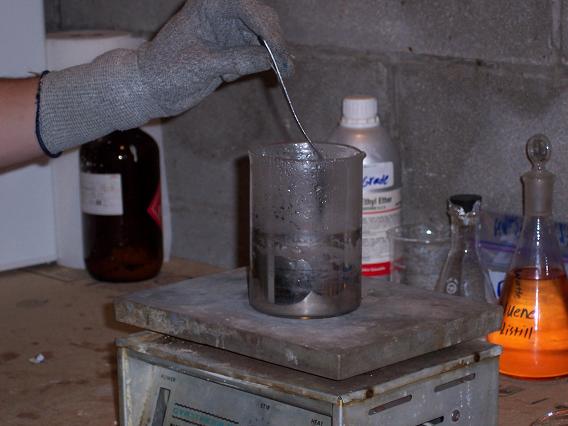
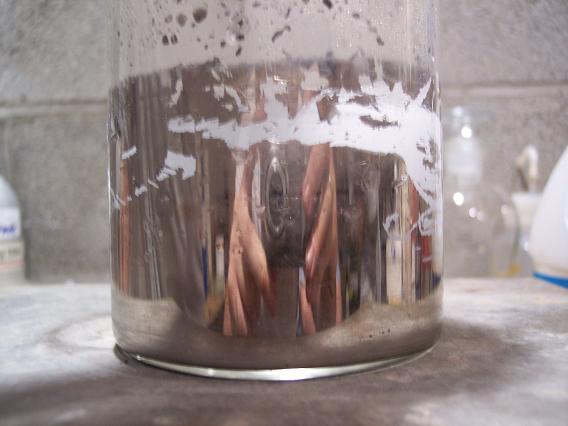
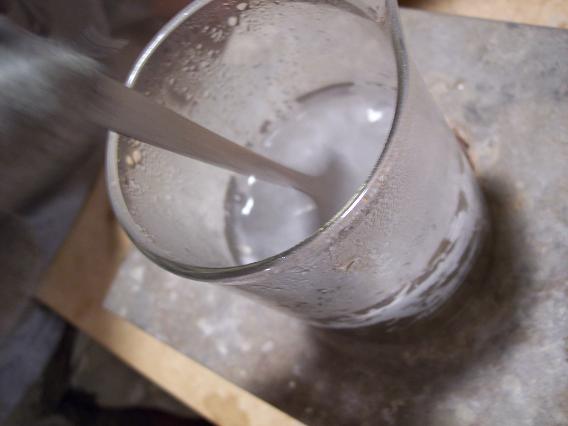
This last one is an action shot.
Thankfully the platinum comes off with the spoon as thin flakes of foil. Otherwise it would be hell to get off the beaker. 
Hope you liked it. Any interesting mirrors of your own are welcome to be posted here. It would be cool to get a discussion going on why this process
occurs. I think it occurs from using really clean glassware (the beaker was fresh out of the oven) and really pure chemicals. It's been my experience
that impure chemicals means less mirror formation.
Vir sapit qui pauca loquitur.
|
|
|
Formatik
National Hazard
   
Posts: 927
Registered: 25-3-2008
Member Is Offline
Mood: equilibrium
|
|
That's neat. Gold compounds can also form mirrors. I have made one by mistake once and it turned the bottom half of the inside of a glass flask into
gold, similar to your Pt mirror. It could be wiped off with a tissue.
|
|
|
Magpie
lab constructor
    
Posts: 5939
Registered: 1-11-2003
Location: USA
Member Is Offline
Mood: Chemistry: the subtle science.
|
|
Yes, NERV, that is neat. The first time I saw a mirror was a silver mirror formed from the Tollens reagents when testing for an aldehyde. I was
surprised and delighted upon first seeing it.
I recently read someplace that copper mirrors can be formed also.
|
|
|
Jor
National Hazard
   
Posts: 950
Registered: 21-11-2007
Member Is Offline
Mood: No Mood
|
|
http://www.versuchschemie.de/topic,7012,-Kupferspiegel.html
|
|
|
woelen
Super Administrator
        
Posts: 8080
Registered: 20-8-2005
Location: Netherlands
Member Is Offline
Mood: interested
|
|
This last experiment is not easy to perform. I tried it, but I had no success. I only got a flocculent precipitate of copper metal, but not a nice
mirror.
|
|
|
Axt
National Hazard
   
Posts: 858
Registered: 28-1-2003
Member Is Offline
Mood: No Mood
|
|
<b>A Method of Depositing Copper upon Glass from Aqueous Solutions in a Thin Brilliantly Reflecting Film, and thus Producing a Copper
Mirror</b>. Chattaway, F. D. Proceedings of the Royal Society of London, Series A: Mathematical, Physical and Engineering Sciences
(1908), 80 88-92.
Abstract
See C. A., 1908, 1; 936. This gives more details. The author uses "finely divided, black copper oxide suspended in a boiling saturated solution of
phenylhydrazine or a liquid made by mixing the latter with a solution of copper hydroxide in alkaline tartrates or ammonia." Glass must first be
thoroughly cleaned and then placed in the boiling hydrazine solution. The copper deposits out from the cuprous state as a thin reflecting film.
<b>A Method of Depositing Copper upon Glass from Aqueous Solutions in a Thin Brilliantly Reflecting Film, and thus Producing a Copper
Mirror</b>. Chattaway, F. D. Chem News (1908), 97 19.
Abstract
Just as the author had previously found (Trans. Chem. Soc., 1907) that Iree oxygen oxidizes phenylhydrazine, especially in presence of KOH, producing
benzene, nitrogen and water, so he finds that CuO oxidizes it, the copper being deposited on the glass vessel in the form of a fine mirror. Excellent
results are obtained by proceeding as follows: "Heat a mixture of one part of freshly distilled phenylhydrazine and two parts of water until a clear
solution is obtained. To this add about half its bulk of a warm saturated solution of cupric hydroxide in ammonia. Nitrogen is freely evolved during
the addition and the cupric is reduced to cuprous hydroxide, which remains dissolved in the ammoniacal liquid, and does not undergo any immediate
appreciable further reduction until heated. Add next a hot 10% solution of KOH until a slight permanent precipitate of cuprous hydroxide is produced.
If this colorless or pale yellow liquid be cautiously heated in contact with a perfectly clean glass surface, metallic copper is deposited upon it in
the form of a thin coherent perfectly reflecting lamina." The evolution of nitrogen and the production of tarry matter which with the benzene rises
to the surface, make it necessary to take special precautions to keep the liquid uniformly in contact with the inner surface of the vessel, if one
wishes to secure a continuous film at one operation. To make the film permanent and to prevent its superficial oxidation, it should be left at least
an hour with the warm reducing solution and until the temperature of the air is reached. The film should then be washed in turn with water, alcohol
and ether, and finally should be covered with one or two coats of a quick-drying varnish. The same solution can be used repeatedly after filtering
while warm and adding more ammoniacal copper solution, and more phenylhydrazine if needed. To preserve it, it must be well protected from air. The
mirrors obtained by this process are as perfect reflectors as those obtained by the deposition of silver.
The surface to be coated is best cleaned by rubbing it in turn with cotton pads soaked in strong soap solution, strong nitric acid and strong caustic
potash and rinsing well between the successive operations. The formation of the mirror directly from monovalent copper shows the analogy between
cuprous copper and silver. Since the production of a metallic mirror by deposition from solution seems to require that the reaction shall be more
rapid at the surface of the container than in the body of the solution, the author suggests that the action of the glass is catalytic. If so, this
property varies with the preparation and previous exposure of the surface, both silver and copper depositing much better upon blown than upon polished
glass, and better on that which had not been long exposed to the action of air or water.
<b>Precipitation of a copper mirror on glass</b>. Barmashenko, I. B.; Voronin, M. M. Polytech. Inst., Kiev, Legka Prom.,
Nauk.-Tekhn. Zb. (1963), (2), 16-20.
Abstract
Various methods for the formation of Ag and Cu mirrors on glass, particularly the production of thermos bottles, are discussed. Expts. show that Ag
was successfully replaced by Cu in the production of thermos bottles. The formation of a Cu mirror on the glass surface by the redn. of Cu ammoniates
with CH2O or with hydrazine sulfate was studied exptl. The redn. with CH2O had the advantage in that it proceeded at room temp., but the results were
less reproducible, and the Cu film peeled off. The redn. with hydrazine sulfate at 96-98, gave reproducible results, and the Cu mirror was stable.
The working soln. consisted of 10 ml. aq. CuSO4 soln. (65 g./l.), 8 ml. aq. NH3 (1%), 30 ml. aq. hydrazine sulfate (2%), and 4.8 ml. 10% NaOH. The
glass surface had to be pretreated with French chalk, with HNO3, and primed with AgNO3 soln.
[Edited on 17-6-2008 by Axt]
|
|
|
Axt
National Hazard
   
Posts: 858
Registered: 28-1-2003
Member Is Offline
Mood: No Mood
|
|
Patent US1935520 describes a copper-silver alloy mirror.
Patent Application IT19571029: A chem. Cu plating bath for glass consists of CuSO4.aq. 60, Seignette salt 140, NaOH 140 g.; and distd. H2O 20 l. The
reducing bath, added to the Cu bath, consists of formalin 1000 cc., glucose 50, and NaOH 40 g. Near the end of usefulness of the combined bath it is
combined with 2% of a soln. of Pb nitrate, 60 g. in 1000 cc. of distd. H2O.
Attached is "A copper mirror: electroless plating of copper". Hill, John William; Foss, Dennis L.; Scott, Lawrence William. Univ. Wisconsin,
River Falls, WI, USA. Journal of Chemical Education (1979), 56(11), 752.
Theres a lot of other metal mirrors, but its hard find purely chemically deposited ones. You can try <a
href="http://v3.espacenet.com/results?sf=n&DB=EPODOC&PGS=15&CY=ep&NUM=DE2245761&LG=en&ST=number">DE2245761</a> for a
chemically deposited cobalt mirror.
[Edited on 17-6-2008 by Axt]
Attachment: A Copper Mirror - JCE, 56, 752, 1979.pdf (653kB)
This file has been downloaded 1517 times
|
|
|
Klute
International Hazard
    
Posts: 1378
Registered: 18-10-2006
Location: France
Member Is Offline
Mood: No Mood
|
|
beautifull, NERV. Must have been a hard decision to scrap it off 
\"You can battle with a demon, you can embrace a demon; what the hell can you do with a fucking spiritual computer?\"
-Alice Parr
|
|
|
NERV
Hazard to Others
  
Posts: 152
Registered: 22-9-2002
Location: USA
Member Is Offline
Mood: Fluorinated
|
|
| Quote: | Originally posted by Klute
beautifull, NERV. Must have been a hard decision to scrap it off 
|
It was quite beautiful, but in the end it wasn't to hard a decision to remove it. I need the money from refining it to fund my chemical pursuits.
Sadly home chemistry is not a cheap hobby constantly having to stock up on chems, and new equipment is difficult.
Interestingly I have noted that hydrazine hydrate does not have the same plating effect as the sulfate. I am guessing this would have to do with the
slower formation of freebase hydrazine in a basic aqueous solution as compare the instantaneous reduction with pure hydrazine hydrate. Time to make
more hydrazine hydrate I guess as removing platinum plating is a pain in the arse.
A sample of some of the buttons Fleaker & me have refined in the past two weeks.
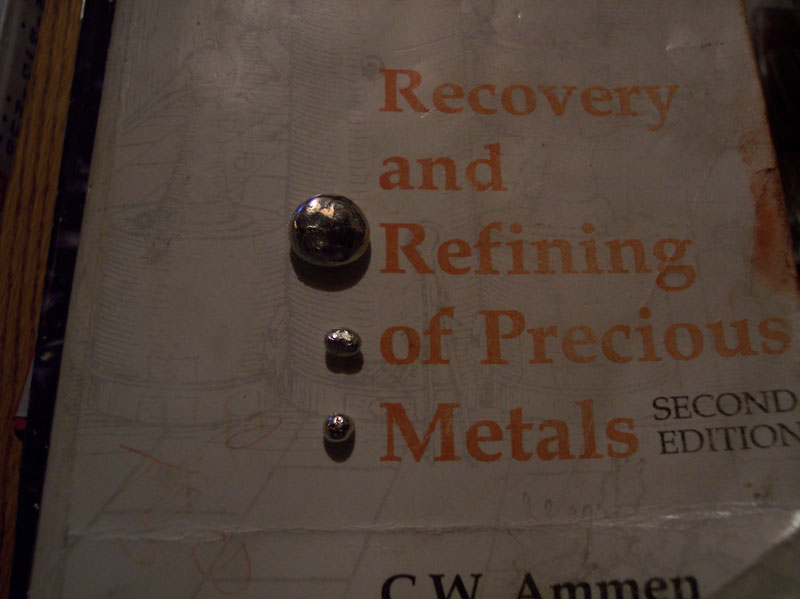
Vir sapit qui pauca loquitur.
|
|
|
Zinc
Hazard to Others
  
Posts: 472
Registered: 10-5-2006
Member Is Offline
Mood: No Mood
|
|
How do you melt the platinum into ingots?
|
|
|
NERV
Hazard to Others
  
Posts: 152
Registered: 22-9-2002
Location: USA
Member Is Offline
Mood: Fluorinated
|
|
Melting into ingots is actually quite difficult which is why we melt them into buttons. Essentially we place the platinum powder into a small alumina
crucible (max capacity about 5-6g platinum powder per shot) then we melt it down using our oxy propane torch. It is quite an experience melting
platinum down with blistering white heat giving your hands a tan, and fusing Al2O3 into a glass like material  !!!! !!!!
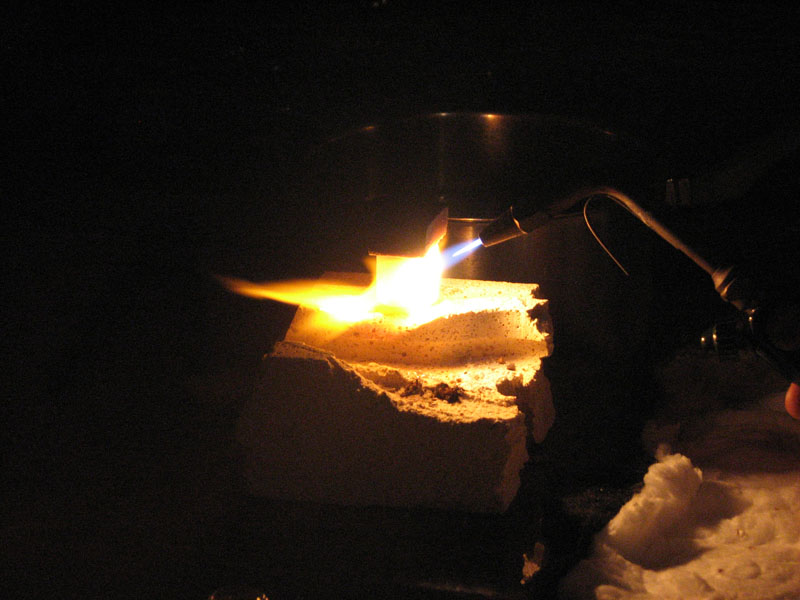
Vir sapit qui pauca loquitur.
|
|
|
Klute
International Hazard
    
Posts: 1378
Registered: 18-10-2006
Location: France
Member Is Offline
Mood: No Mood
|
|
That is a very cleevr financial ressource! Do yourecover the Pt from "scrap" metals?
I have aquired a fair amount of various old electrodes that were thrown away at work, most o fthem have Pt wire isnide, whatever their application.
I'm planning on dismantaling most of them to recover as much Pt as possible, and make a few reference elctrodes (most of them have been emptied, but
not all: some contain some mercury, calomel, etc, and beleive it or not simply thrown in the bin were desktop rubbish is put... What a
healthy/environmental act...
I'll see how much I can salvage,a nd might consider melting it, get a free Pt electrode would be nice!
EDIT: Actually, it seems it woul dbe very easy to form Adams' catalyst from scrap Pt metal, a simple dissolution in aqua regia followed by
neutralization with ammonia to form ammonium hexachloroplatinate, which is thne fused with sodium nitrate, piece of cake 
Considering the price of the catalyst, it really looks worth it.
Out of curiosity, how much do you sell your refined metal (I understand If you don't want to share that  )? )?
[Edited on 19-6-2008 by Klute]
\"You can battle with a demon, you can embrace a demon; what the hell can you do with a fucking spiritual computer?\"
-Alice Parr
|
|
|
NERV
Hazard to Others
  
Posts: 152
Registered: 22-9-2002
Location: USA
Member Is Offline
Mood: Fluorinated
|
|
My buyer is very generous so I can usually get close to spot price on the refined metal. Yes I do recover most of my PGMs from scarp metal although
allot of the time I recover it from old stocks of PGM salts that were disposed of.
If your are planning on making catalyst with your Pt the best way to go about it would be to form a solution of hexachloroplatinic acid via AC
electrolysis of platinum wire in HCl. From there your can perform a reduction onto activated carbon using either formic acid or hydrazine IIRC. I can
dig through some of my papers and find more detail procedures if you would like.
EDIT: These electrodes actually came out of a coulombmeter and are in fact used to measure the mass of metal deposited on them. Although if you have
wire it is very easy to fuse it into a glass tube to make your own Pt electrodes.
[Edited on 22-9-2002 by NERV]
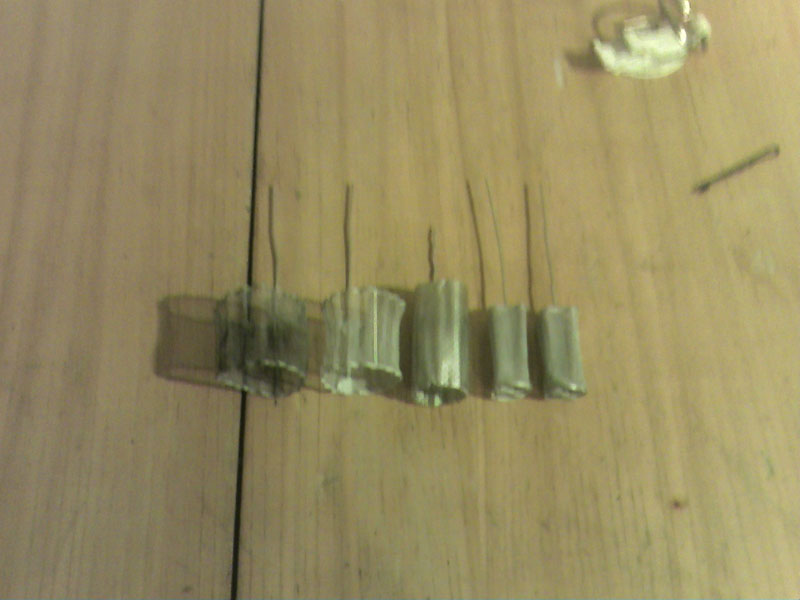
Vir sapit qui pauca loquitur.
|
|
|
Klute
International Hazard
    
Posts: 1378
Registered: 18-10-2006
Location: France
Member Is Offline
Mood: No Mood
|
|
I woul dlove those references!
I remember using those electrodes to titrate copper solutions, by plating copper from a Cu2+ solution and mesuring the weight diffference. I bet they
must be expensive to buy!
The whole pT catalyst is actually looking like a very appealing idea, but once I depleted the electrodes I'm pretty much done unless I cna find
another source of Pt..
i remeber lots of discussion on getting old catalytic converters, but I dunno if it would really be worth the effort.
The Pt electrolysis is smart, as I only have 53% HNO3 which makes a weak aqua regia. I'm not sure what to use to clap the Pt wire though (in small
pieces), asa no crocodiles would surely get corroded from being just over the surface (from HCl droplets du to gas evolution?).. Anya dvice?
I could just concentrate some HNO3, won't be needing much anyway I suppsoe?
EDIT: surely you mean mesuring electrodeS? How can a Pt electrode be a reference? Using H2/H+?
[Edited on 19-6-2008 by Klute]
\"You can battle with a demon, you can embrace a demon; what the hell can you do with a fucking spiritual computer?\"
-Alice Parr
|
|
|
NERV
Hazard to Others
  
Posts: 152
Registered: 22-9-2002
Location: USA
Member Is Offline
Mood: Fluorinated
|
|
I did indeed mean measuring electrodes, although I have used them as workhorse electrodes in chlorate/perchlorate synthesis.
| Quote: | The Pt electrolysis is smart, as I only have 53% HNO3 which makes a weak aqua regia. I'm not sure what to use to clap the Pt wire though (in small
pieces), asa no crocodiles would surely get corroded from being just over the surface (from HCl droplets du to gas evolution?).. Anya dvice?
I could just concentrate some HNO3, won't be needing much anyway I suppsoe? |
In my experience it is very difficult to dissolve Pt (or most any PGM for that matter) into aqua regia even when concentrated. I would defiantly
concentrate your HNO3 or else your dissolution will be pitifully slow. I normally use 98% red fuming nitric acid in my aqua regia solutions. I am
assuming that you mean Alligator clips when you say crocodile, and yes I am sure they would get dissolved by the spray. Your best bet would be to make
a sealed glass platinum electrode to do the dissolution. The excess Pt left in the glass could be collected twords the end by breaking the glass and
then dissolving them in an aqua regia solution for further recovery. That is how I would go about it personally since it is piss easy to make a glass
to platinum seal.
I am having some trouble finding some of my original PDF files on the catalysts (I really need to take a day to sort out all of my PDFs), but here are
a couple of links that can lead you to quite a bit of useful information.
Palladium/Platinum catalyst preparation. There are many great refrances at the end of this article.
Palladium (II) Chloride.
Vir sapit qui pauca loquitur.
|
|
|
Klute
International Hazard
    
Posts: 1378
Registered: 18-10-2006
Location: France
Member Is Offline
Mood: No Mood
|
|
Ok, I guess I will try that, using copper wire inside the glass.. I will try to keep the wires as long as possible..
I was wondering if PtO2 on carbon would be of an utility (not the directly reduced Pt/C),as it would be easier to recover by filtration than Pt black
from PtO2 reduction... I don't think the supported PtO2 would offer a less dispersed Pt than free PtO2?
\"You can battle with a demon, you can embrace a demon; what the hell can you do with a fucking spiritual computer?\"
-Alice Parr
|
|
|
NERV
Hazard to Others
  
Posts: 152
Registered: 22-9-2002
Location: USA
Member Is Offline
Mood: Fluorinated
|
|
Yes do try to keep the wires as long is possible. If they are already long enough in the original electrode casing then I would use them as is in the
dissolution. Collection of the remaining wire shouldn’t be difficult as I have freed small Pt leads out of glass with a hammer. You just have to
watch out for broken glass wile you’re working. Then just mix up some weak aqua regia to dissolve the crap away wile you work with the
chloroplatinic acid produced.
As for PtO2 on carbon I am not entirely sure how that would work out, a little experimentation may be in order. I have never attempted it simply
because I have a few grams of ready made Adams catalyst so I never had to bother. I thought about it a bit though, and this is how I would approach
the manufacturing of this catalyst. I would first collect all of my chloroplatinic acid from the electrolysis and either dry it (difficult), or get a
quantitative concentration from the solution using the method from the attached PDF since I have some access to a spectrophotometer (there are many
other ways to find the concentration of the solution, Fleaker would be more knowledgeable on that though). After determining the concentration I would
add a known excess of Na2NO3(aq) to the H2PtCl6 solution, and begin stirring with some activated carbon (the qty. would depend on how well PtO2 bonds
to carbon, and the percent mass PtO2 you wanted). From there I would simply heat the mix in a porcelain dish with stirring under an inert atmosphere
(PtO2 is known for being somewhat pyrophoric) until the mix concentrates to a homogeneous mass. Then just continue to blast it with heat in the
500-600’C rang until the release of nitrogen dioxides ceases and you are left with what you hope to be PtO2 on carbon.
All it is a simple modification of a method for producing unsupported PtO2 seems simple enough on paper. Obviously this would need some tinkering
with in reality but in theory it still sounds very promising IMHO. I am sure Fleaker would be able to help you out here much more then I can he is
much more skilled with PGM chemistry than I am, and he has had some experience with creating supported catalysts for a project. I much more prone to
be the one using the finished catalysts than actually manufacturing it.
EDIT: Plus most of the time I am trying to get a PGM salt I received reduced back down to metal, and then melted into buttons for sale. I have enough
catalysts in stock to last me a fair amount of time. So I never had a need to make em.
[Edited on 22-9-2002 by NERV]
Attachment: Reactions involving colored complexes of PGMs.pdf (751kB)
This file has been downloaded 1140 times
Vir sapit qui pauca loquitur.
|
|
|
Klute
International Hazard
    
Posts: 1378
Registered: 18-10-2006
Location: France
Member Is Offline
Mood: No Mood
|
|
Thanks for the comments. Iw as htinking going through ammonium chloroplatinate? As it is easier to dry and weigh out correctly.
I haven't had time to scavenge the electrodes yet, will surely do so next week and take pictures.
\"You can battle with a demon, you can embrace a demon; what the hell can you do with a fucking spiritual computer?\"
-Alice Parr
|
|
|
chemkid
Hazard to Others
  
Posts: 269
Registered: 5-4-2007
Location: Suburban Hell
Member Is Offline
Mood: polarized
|
|
How about an aluminum mirror? I have read about there use in instruments, but it probably won't be too easy to deposit aluminum.
Chemkid
|
|
|
a_bab
Hazard to Others
  
Posts: 458
Registered: 15-9-2002
Member Is Offline
Mood: Angry !!!!!111111...2?!
|
|
The aluminium is not chemically deposited, but in vacuum via an electric discharge, or it can be done via the vaporisation of hot Al in vacuum.
|
|
|
Panache
International Hazard
    
Posts: 1290
Registered: 18-10-2007
Member Is Offline
Mood: Instead of being my deliverance, she had a resemblance to a Kat named Frankenstein
|
|
I have some palladium chloride (anhydrous if that's significant), how would i turn this into an easily mirror-able solution. I know i should read
through all the references but in reality i won't do it so if someone has the knowledge off hand and doesn't mind quickly summarising it, i would
appreciate it. I will post photo's!!, what glassware should i mirror, maybe the coil of an internally coiled condenser, that would look interesting.
Regarding the Al mirror, just look on the inside of a bag of crisps, its the same deposition technique, it is incredible how it is done on the scale
for the price, but i guess we did land on Moon! (i just bought the Seinfeld Series on DVD now everything i say and do is infused))
[Edited on 10-7-2008 by Panache]
|
|
|
Per
Hazard to Others
  
Posts: 134
Registered: 26-1-2007
Location: Europe
Member Is Offline
Mood: No Mood
|
|
| Quote: | | In my experience it is very difficult to dissolve Pt (or most any PGM for that matter) into aqua regia even when concentrated. I would defiantly
concentrate your HNO3 or else your dissolution will be pitifully slow. |
Instead of HNO3 hydrogene peroxide and HCl could also be employed, so I´m dissolving Pt and Rh from car catalysts. But if the Pt piece is thicker,
like a wire, I assume that it would also take a very long period of time to dissolve it.
Also preparing ClO3 and ClO4 with a platinum electrode isn´t a good idea, because some of the Pt is always eroded and after a determined time your
whole electrode is dissolved.
Klute, Brauer from the forum library has also interesting references about Pt-catalysts and their preparation.
Because of the fact that palladium salts are about as good oxidisers as Pt salts, the preparation of palladium mirrors should be similar/the same to
that of Pt mirrors.
|
|
|
argyrium
Hazard to Others
  
Posts: 123
Registered: 3-2-2008
Location: Pacific
Member Is Offline
Mood: No Mood
|
|
The .pdf attached was kindly OCRed by a friend. I have not tried any of these - yet.
COLOURED MIRRORS Bruno Schweig Mirrors Pelham Books London 1973
Has anyone here had experience electroforming Au onto dental silicone impression material (RTV)? I have a small (~6-mm D) repoussé disk that needs
to be reproduced. It is too thin to cast - which would otherwise be the "simple" solution.
I have been trying to think of how to establish an initial metallic film (Cu or Ag that could be later dissolved) onto the silicone and then build up
the Au onto that - or directly from Au. Have not tried any processes yet but suspect the silicone, being so non polar/hydrophobic will present
difficulties.
WP dissolved in solvent added to AuCl3 solution? Dusting Fe filings onto the silicone through a CuSO4 sol.? Graphite?
Thank you
[Edited on 10-8-2008 by argyrium]
Attachment: COLOURED MIRRORS.pdf (31kB)
This file has been downloaded 1914 times
|
|
|
argyrium
Hazard to Others
  
Posts: 123
Registered: 3-2-2008
Location: Pacific
Member Is Offline
Mood: No Mood
|
|
This is a photo of the gold disk that needs to be reproduced - it has since been removed from the mounting.
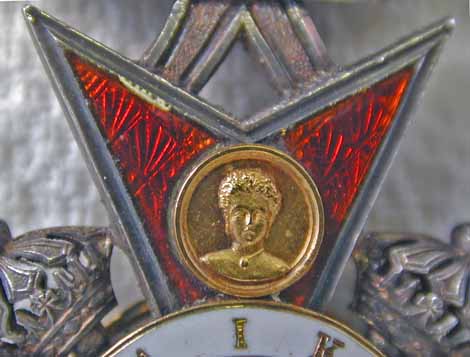
|
|
|
Fleaker
International Hazard
    
Posts: 1252
Registered: 19-6-2005
Member Is Offline
Mood: nucleophilic
|
|
| Quote: | Originally posted by Panache
I have some palladium chloride (anhydrous if that's significant), how would i turn this into an easily mirror-able solution. I know i should read
through all the references but in reality i won't do it so if someone has the knowledge off hand and doesn't mind quickly summarising it, i would
appreciate it. I will post photo's!!, what glassware should i mirror, maybe the coil of an internally coiled condenser, that would look interesting.
|
I would save your PdCl2 for more fruitful things, like palladium on carbon. NERV and I are doing an Illustrated guide on making Pd/C. In general, you
can treat Pt and Pd as equals. If you're still dead set on making a mirror, I suggest adding hydrazine sulfate to an ammoniacal solution of the PdCl2.
@Per,
H2O2-HCl or NaOCl-HCl is a common trick I use for dissolving gold. It only works for platinum if the platinum is in a finely divided state. If it is
wire, or even a decently thick foil, it is not time efficient to even bother. Hence using hot aqua regia.
As for using Pt as an electrode for perchlorate (not chlorate, that is feedstock) there are few problems. Granted, after a determined time, your Pt
electrode will be gone. Fact of the matter is, if your electrolysis is running properly, that determined amount of time is a very long time.
I don't have the references handy to me, but I have a paper that discusses the erosion rates of Pt electrodes employed in such an endeavor. I recall
thinking about how little is actually lost per given area at a given current density.
Neither flask nor beaker.
"Kid, you don't even know just what you don't know. "
--The Dark Lord Sauron
|
|
|
| Pages:
1
2 |